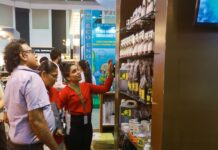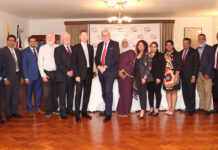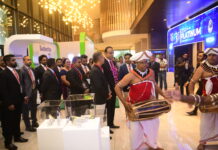By Rantha Tissera, Treasurer, Sri Lanka Chamber of Garment Exporters and Managing Director of Estilo Apparel
In Sri Lanka, small business is a very big deal. The numbers tell the story. The Department of Census and Statistics, in its decennial Economic Census of 2013/14, found that over 99 per cent of all business establishments are micro, small and medium enterprises (MSMEs).
For context, consider that they account for 52 per cent of GDP, and 42 per cent of private sector employment. In other words, they are the backbone of the Sri Lankan economy. Micro-enterprises account for 92 per cent of 1 million plus business establishments.
Unpackaging those numbers can help arrive at a better understanding of position, priorities and policy. Industry contributes almost 27 per cent of Sri Lanka’s GDP; about 28 per cent of the labour force works in industry as a whole, mostly in manufacturing.
The Annual Survey of Industries 2018 (ASI) covers 28 industry sectors, of which manufacturing comprises 91 per cent. Food processing and apparel are the largest in terms of output (LKR 1.48 and LKR 1.1 trillion respectively in 2017) and employment (333,000 and 730,000). These numbers, however, include micro-enterprises, which are a significant fraction.
Apparel – which this article focuses on – accounts for almost half of Sri Lanka’s merchandise exports, at an estimated $5.2 billion in 2019. SMEs are a significant contributor, as 80 per of them are an inseparable part of the apparel supply chain, and sub-contract for large manufacturers.
A report on the impact of Covid-19 on SMEs in May 2020 put the number of workers in the apparel sector at between 300,000 and 400,000 of which 20,000 are employed by members of the Sri Lanka Apparel Exporters Association This is broadly in line with the estimates from 2013-14 and the ASI 2018. Simply put, SMEs in the apparel sector are a critical factor in the industry’s global success.
The pandemic created some serious disruptions, many of which we are still dealing with. But apparel SMEs have also adapted quickly, changing processes to produce masks and other personal protection equipment (PPE), for example, and adopting new technologies to meet different needs.
Arguably, the best-known and successful SME ecosystem globally is the Mittelstand, the model made famous in Germany, though many countries in Europe have similar models. ‘Mittelstand’ means ‘middle class’ in business terms; but its performance and capabilities’ are world-class.
99 per cent of German companies are Mittelstand companies; they account for 68 per cent of exports. About 80 per cent are B2B firms, and their customers are global leading and brands themselves. A Mittelstand firm’s revenue is €50 million and less than 499 employees (compared to a Sri Lankan SME which has a revenue of LKR 250-750 million and less than 300 employees).
If that sounds familiar, it should be. Sri Lanka’s apparel SMEs share numerous similarities with Mittelstand companies. Most are family-run with a family-culture orientation, and are innovative and adaptive.
They have a high degree of social responsibility, practise ethical manufacturing and meet global sustainability standards, as a World Bank global value chain analysis report found, when comparing the apparel industries in Bangladesh, Sri Lanka and Turkey.
Even though the pandemic was a shock, Sri Lanka’s SMEs adapted to changed circumstances not just with Personal Protective Equipment (PPE) manufacturing; they leveraged each other’s capabilities to ensure delivery deadlines to their customers were met. When air travel was suspended, they resolved the problem of sending buyers samples by innovatively using 3D printing technology.
There are other important elements, too. Mittelstand companies make decisions that are based on generational considerations; the cultural orientation of a family-owned business model is to plan for long-term existence. Investments and employees become important. Employee turnover is very low, less than 3.2 per cent a year, according to studies.
They form competitive clusters: a geographic concentration of suppliers and other inter-connected businesses. This allows specialisation and competitive superiority – which is crucial for export-oriented businesses.
One example is the Baden Wurttemburg region where companies are engaged in machine tool manufacture, and have become a centre of the engineering excellence Germany is famous for. Silicon Valley, or Tokyo’s Otaku district in Japan are examples outside Germany.
An unnoticed element of the German SMEs is the existence of global leaders that are mostly unseen by consumers. Jungbunzlauer is Coca Cola’s citric acid supplier for all the company’s production plants around the world, and Uhlman is the world’s leading producer of pharmaceutical packaging material. Of particular intertest to Sri Lanka, given its fisheries exports, should be Tetramin, the world’s number one producer of fish food.
It is hard to capture the value that Sri Lankan apparel SMEs add in a simple numerical value. There are Sri Lankan SMEs that serve niche markets similar to the ones described in the preceding paragraphs.
The takeaway from all this is that the Mittelstand is an ecosystem, not just a business model, and creating that kind of ecosystem can make Sri Lanka’s apparel SMEs globally competitive for decades into the future. So what can be done?
The adaptability of Sri Lankan SMEs is often forced by circumstances, not nurtured or created. Workflow and orders tend to be volatile; true, apparel is a business that is fashion-driven and fashions change every season, but a minimum degree of sustainable workflow is necessary, so that SME factories are not idle for three months every year as they are now.
This volatility has adverse impact on the workforce, forcing them to seek more permanent and stable employment in other areas than manufacturing. As the Mittelstand system shows, a committed workforce is critical; SMEs can then make investments in training that can create world-leading products, and background integration into the education system. One of the Mittelstand’s outstanding features is workforce training.
Most Sri Lankan apparel SMEs need exposure to global markets and technology. If they are going to emulate the Mittelstand, they have up-grade the technology they currently use, based on what the global markets want. Remember that Mittelstand companies also export to global markets directly.
All of the above also requires the SMEs to be enveloped into the formal financial system. Sri Lankan SME growth is not debt-dependent; what is essential is access to finance to smooth over the impact of volatile workflow, and investment in technology up-grades as needed.
As we recover from this pandemic, we also have to ‘vaccinate’ Sri Lanka’s economic spine against future health threats. To stride forward to economic growth and prosperity, adding muscle to the country’s economic backbone is crucial.
It will take a combination of government policy, the larger apparel industry in Sri Lanka as a whole, our buyers overseas and SMEs to come together to make that happen. And the time for that is now.
Rantha Tissera is Managing Director, Estilo Apparel, a Sri Lankan SME. He is also the Treasurer of the Sri Lanka Chamber of Garment Exporters.












